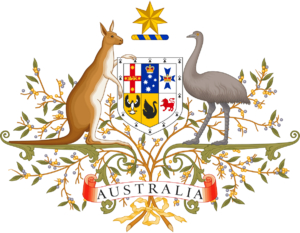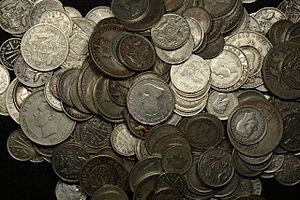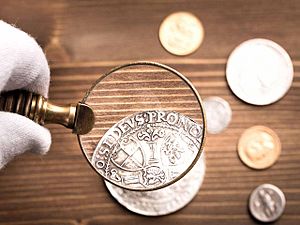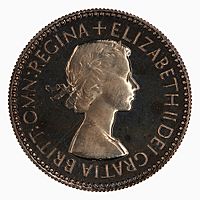Sixpence (Australian) facts for kids
The Australian sixpence was a coin used in Australia from 1910 until 1966. That's when Australia changed its money system to decimal currency. At first, these coins were made in England. But from 1916, Australia started making its own sixpence coins. They were made at branches of the Royal Mint in Sydney and Melbourne.
Before 1966, Australia's coins were very similar to British money in their weight and size. The Coinage Act of 1909–1947 allowed Australia to make its own coins, including the sixpence. By 1916, all silver coins, like the sixpence, could be made at the Royal Mint in Melbourne. In 1966, Australia created its own unique money system with decimalisation.
Back when the sixpence was used, Australian life was quite "English." Money was part of everyday sayings and games. For example, "a pound for a pound" was good news for wool growers. Games like "two-up" needed pennies to play. There were also slang words for money, like "zac" for a sixpence. Even though the sixpence isn't used anymore, the word "zac" is still sometimes heard in Australia.
Contents
How the Sixpence Coin Started
The Commonwealth of Australia was formed in 1901. This happened when six self-governing colonies joined together.
When Australia became a Commonwealth in 1901, its money included gold, silver, and bronze coins from the United Kingdom. The first Australian sixpence was just like the British one in its weight and how pure the silver was. The Coinage Act of 1909 made Australian sixpence, florin, shilling, threepence, penny, and half-penny coins official money.
This 1909 Act said that silver coins should be "925 fine." This meant that for every 1000 parts of the coin, 925 parts had to be pure silver. The rest was copper alloy, which is a mix of copper and other metals.
On March 1, 1910, a ship called R.M.S Otranto arrived in Sydney. It carried the first Australian silver shillings from the Royal Mint in London. Other coins, including the sixpence, arrived later that year. These coins completed the new set of Australian silver money. The very first Australian coins had a picture of Edward VII on them. But he had actually died before the coins even reached Australia!
The word "sixpence" comes from "saxpence." Another common name for the sixpence was "zac." This word was first used in Australian English around the 1890s. It also meant "a very small amount of money." Even though the sixpence is no longer used, the word "zac" is still remembered fondly in Australia.
Designs on the Sixpence
There's a cool tradition with British coins. The direction the monarch faces changes with each new ruler. This is thought to have started with King Charles II. He didn't want his portrait to face the same way as Oliver Cromwell. Cromwell was the man who had ordered his father's execution. So, Charles II turned his back on him, in a way.
The design of the Australian sixpence was special because it didn't change for 50 years. This makes it the coin that changed the least! The last sixpence, made in Melbourne in 1963, looked exactly the same on its back side as the very first one made in London in 1910.
Early Sixpence Designs
- 1910: The front of the sixpence in 1910 showed King Edward VII. He was wearing his crown and robes, facing to the right. The back of the coin had the Commonwealth of Australia's coat of arms. This design was approved by the King. William DeSaulles, who was the main engraver at the Royal Mint, designed the front of the Edward VII sixpence. You can see his initials, DES, at the bottom of the 1910 sixpence.
- 1911–1936: The first coins arrived in Australia after King Edward VII had passed away. When he died in 1910, George V became the new King. So, coins made after 1911 showed King George V. He was crowned and facing to the left on the front of the coin.
Later Sixpence Designs
- 1938–1952: King George VI became King on December 10, 1936. This happened after Edward VIII decided to step down from the throne. A coin designer named Thomas High Paget was asked to join a competition to design new coins for Edward VIII. Paget's design was chosen, but it was never used because Edward VIII left the throne. Paget then created a new design for King George VI's coronation. This coin showed him looking to the left, but without a crown. The only thing that changed on the George VI coin was the writing on the front. Different words appeared on the coins between 1938-1948 and 1950–1952.
- 1953–1963: Queen Elizabeth II became Queen after her father, George VI, died in February 1952. The designs on Australian coins changed to show a picture of the Queen on the front. The back of the coin stayed the same. Just like with King George VI's coin, the writing on Queen Elizabeth II's coin changed between 1953–1954 and 1955–1963.
The sixpence was the only pre-decimal coin whose back design never changed. The back showed a coat of arms approved by Edward VII in 1908. This design featured a shield from the Australian coat of arms. It was held up by a kangaroo and an emu, with a seven-pointed star on top. The words 'Advance Australia' were written on a scroll underneath. This is interesting because the 1908 coat of arms was actually changed in Australia in 1912. So, the design on the sixpence was outdated for most of the time it was used! The new version of the coat of arms didn't appear correctly on a coin until the 1966 50 cent piece.
Government records show that in 1951, over 13.7 million sixpence coins were made. These coins were produced at the Melbourne Mint. However, if you look closely with a magnifying glass, you might see the letters "PL" engraved on some. This "mintmark" means the coin was actually made at the Royal Mint in London.
How Much is a Sixpence Worth?
The 1918 sixpence is the most rare and valuable. It can be worth about $40 AUD if it's in "extremely fine" condition. If it's in "uncirculated" condition, it could be worth $200 AUD.
Some other rare sixpence coins are from 1916, 1917, 1912, 1920, 1914, and 1911. Coins from 1935 and 1924 are also hard to find.
- Uncirculated: An "uncirculated" coin looks brand new, like it just came from the mint. It has a shiny glow and clear details, especially on the heads of the emu and kangaroo. If you look closely with a magnifying glass, you shouldn't see any flaws. The emu's feathers should look perfect, with no signs of wear.
- Extremely fine: An "extremely fine" coin might have a few small scratches. These scratches often come from the machines that handle the coins. But these coins still have a lot of their original shine.
The sixpence was a very popular coin for everyday buying and selling. Because of this, most sixpence coins were used a lot and became worn out. So, it can be hard for a collector to find all the different types in good condition.
Sixpence Coin Details
| Image | Monarch | Years | Composition | Designers | | ||||||
|---|---|---|---|---|---|---|---|---|---|---|
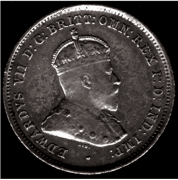 |
King Edward VII | 1910 | 92.5% silver, 7.5% copper | Obverse: George W. De Saulles
Reverse: W.H.J. Blakemore |
||||||
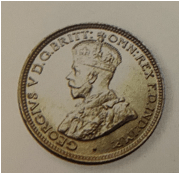 |
King George V | 1911-36 | 92.5% silver, 7.5% copper | Obverse: Thomas H. Paget
Reverse: W.H.J. Blakemore |
||||||
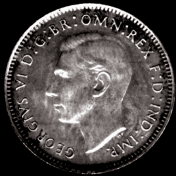 |
King George VI | 1938-45 | 92.5% silver, 7.5% copper | Obverse: Thomas H. Paget
Reverse: W.H.J. Blakemore |
||||||
| King George VI | 1946 - 52 | 50% silver, 40% copper, 5% zinc, 5% nickel | Obverse: Thomas H. Paget
Reverse: W.H.J. Blakemore |
|||||||
| Queen Elizabeth II | 1953 - 54 | 50% silver, 40% copper, 5% zinc, 5% nickel | Obverse: Mary Gillick
Reverse: W.H.J. Blakemore |
|||||||
| Queen Elizabeth II | 1955-63 | 50% silver, 40% copper, 5% zinc, 5% nickel | Obverse: Thomas H. Paget
Reverse: W.H.J. Blakemore |
|||||||
| These images are to scale at 2.5 pixels per millimetre. For table standards, see the coin specification table. | ||||||||||
Australia's Switch to Decimal Money
In the late 1950s, a special committee suggested that the Australian government should think about changing its money system. They wanted to switch from the old "imperial" system to a "decimal" one. A decimal currency would make calculations easier and improve how money was handled. This change was expected to be good for Australia's economy.
Gerard McManus wrote in a magazine in 2014 that the change to decimal money was one of the smoothest and best-handled government projects in Australia's history.
Changing to decimal currency helped Australia become more financially independent. It also helped promote Australian symbols on its new money.
When Australia switched to decimal money, one sixpence became exactly five Australian cents.
Because of this, the new five-cent coin was the exact same size and value as the old sixpence.
Even today, in 2021, the five-cent coin is still the same size and value as the old sixpence. This means that old sixpence coins are still considered legal money in Australia. You might even find one in your change sometimes!
The same thing happened with other old coins. The Shilling became ten cents, and the Florin became twenty cents.
In the United Kingdom, their Shilling and Florin-sized coins were taken out of use in the 1990s. They were replaced with smaller decimal coins. But in Australia, the 10-cent and 20-cent coins have never been made smaller. This means you can sometimes still find old Shillings and Florins in your change too!
Mintmarks on Coins
- D : Denver (a mint in the USA)
- M : Melbourne (a mint in Australia)
- PL : London (a mint in England)
- S : San Francisco (a mint in the USA)


